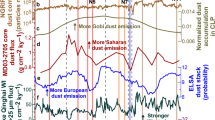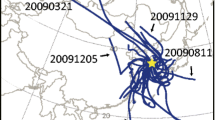Abstract
Insoluble microparticles in ice cores are related closely to the transportation of eolian dust, and thus are important natural media to reconstruct climate change. In this study, we conducted a systematic mineral-magnetic investigation of insoluble microparticles in the Nojingkangsang ice core (29°2.1′N, 90°11.88′E, 5950 m) from the Southern Tibetan Plateau. Results indicate that the dominant magnetic mineral is magnetite, and its concentration has grown significantly since the 1980s, which coincides with trends in climate warming of the Tibetan Plateau. Influenced by regional warming, the glacial recession around Nojingkangsang shortens the distance between the dust source and glacial areas and thus increases the concentration of coarse-grained magnetic minerals in ice cores. However, the frequency of dust storms, associated with annual precipitation, could play only a regulatory role on the magnetic content over yearly (or seasonal) time scales. Therefore, using a new approach, the magnetic index of insoluble microparticles in ice cores of this region is seen as mainly reflecting trends in climate warming.
Similar content being viewed by others
References
Yao T D, Wang N L. Ice core study—The past, the present and the future. Chin Sci Bull, 1997, 42: 1057–1065
Xu J Z, Hou S G, Chen F K, et al. Tracing the sources of particles in the East Rongbuk ice core from Mt. Qomolangma. Chin Sci Bull, 2009, 54: 1781–1785
Thompson L G, Yao T D, Thomposn M E. A high-resolution millennial record of the south Asian monsoon from Himalayan ice cores. Science, 2000, 289: 1916–1920
Petit J R, Briat M, Royer A. Ice age aerosol content from east Ant arctic ice core samples and past wind strength. Nature, 1981, 293: 391–394
Angelis D M, Legrand M, Petit J R, et al. Soluble and insoluble impurities along the 950 m deep Vostok ice core (Antarctica)-climatic implications. J Atmos Chem, 1983, 1: 215–219
Wu G J, Yao T D, Thompson L G, et al. Microparticle record in the Guliya ice core and its comparison with polar records since the last interglacial. Chin Sci Bull, 2004, 49: 607–611
Shi Y F, Yu G. Warm-humid climate and transgressions during 40–30 ka B.P. and their potential mechanisms (in Chinese). Quat Sci, 2003, 23: 1–11
Thompson L G, Hamilton W L, Bull C. Climatological implications of microparticle concentrations in the ice core from ‘Byrd’ station, Western Antarctica. J Glaciol, 1975, 14: 433–444
Gaudichet A, Angelis D M, Lefevre R, et al. Mineralogy of insoluble particles in the Vostok Antarctic ice core over the last climatic cycle (150 kyr). Geophys Res Lett, 1988, 15: 1471–1474
Kyle P, Palais J, Delmas R. The volcanic record of Antarctic ice cores: Preliminary results and potential for future investigations. Ann Glaciol, 1982, 3: 172–177
Yao T D, Jiao K Q, Huang C L, et al. Environmental records in ice cores and their spatial coupling features (in Chinese). Quat Sci, 1995, 15: 23–31
Wu G J, Yao T D. Progress in studies on insoluble microparticles in ice cores (in Chinese). J Glaciol Geocryol, 2005, 27: 528–538
Xu J Z, Sun J Y, Ren J W, et al. Advances in the study of insoluble microparticle in ice-snow on the Qinghai-Xizang Plateau (in Chinese). Adv Earth Sci, 2006, 21: 299–304
Li J L, Hu N G, Xu B Q, et al. Geochemical characteristics of the insoluble microparticles in Purog Kangri ice core: Implications on climate and environment change (in Chinese). Geochimica, 2009, 38: 361–368
Thompson R, Oldfield F. Environmental Magnetism. London: Allen and Unwin, 1986. 49–64
Dekkers M J. Environmental magnetism: an introduction. Geol Mjinb, 1997, 76: 163–182
Lanci L, Kent D V, Biscaye P E, et al. Isothermal remanent magnetization of Greenland ice: Preliminary results. Geophys Res Lett, 2001, 28: 1639–1642
Lanci L, Kent D V, Biscaye P E, et al. Magnetization of Greenland ice and its relationship with dust content. J Geophys Res, 2004, 109: D09104, doi: 10.1029/2003JD004433
Lanci L, Kent D V. Meteoric smoke fallout revealed by superparamagnetism in Greenland ice. Geophys Res Lett, 2006, 33: L13308, doi: 10.1029/2006GL026480
Lanci L, Delmonte B, Maggi V, et al. Ice magnetization in EPICA-Dome C ice core: Implication for dust sources during glacial and interglacial periods. J Geophys Res, 2008, 113: D14207, doi: 10.1029/ 2007JD009678
Sahota J T S, Mayewsky P A, Oldfield F, et al. Magnetic measurements of Greenland and Himalayan ice-core samples. The Holocene, 1996, 6: 477–480
Xu B Q, Cao J J, Hansen J, et al. Black soot and the survival of Tibetan glaciers. Proc Natl Acad Sci USA, 2009, 10: 1073–1077
Li J B. The primary study of dust microparticles in the upper Ningjinggangsang ice core (in Chinese). Master’s Dissertation. Xi’an: Chang’an University, 2009. 1–48
Day R, Fuller M, Schmidt V A. Hysteresis properties of titanomagnetites: Grain size and compositional dependence. Phys Earth Planet Inter, 1977, 13: 260–267
Dunlop D J. Theory and application of the Day plot (M rs/M s versus H cr/H c) 1. Theoretical curves and tests using titanomagnetite data. J Geophys Res, 2002, 107, doi: 10.1029/2001JB000486
Dunlop D J. Theory and application of the Day plot (M rs/M s versus H cr/H c) 2. Application to data for rocks, sediments, and soils. J Geophys Res, 2002, 107: 2057
Evans M E, Heller F. Environmental Magnetism: Principles and Applications of Enviromagnetics. New York: Academic Press, 2003. 22
Deng C L, Shaw J, Liu Q S, et al. Mineral magnetic variation of the Jingbian loess/paleosol sequence in the northern Loess Plateau of China: Implications for Quaternary development of Asian aridification and cooling. Earth Planet Sci Lett, 2006, 241: 248–259
Dunlop D J, Özedemir Ö. Rock Magnetism: Fundamentals and Frontiers. Cambridge: Cambridge University Press, 1997. 342–345
Deng C L, Zhu R X, Yuan B Y. Rock magnetism of the Holocene eolian deposits in the Loess Plateau: Evidence for pedogenesis. Mar Geol Quat Geol, 2002, 22: 37–45
Ju Y T, Wang S H, Zhang Q P, et al. Mineral magnetic properties of polluted topsoils: A case study in Sanming City, Fujian Province, southeast China (in Chinese). Chin J Geophys, 2004, 47: 282–288
Maher B A. Magnetic properties of modern soils and Quaternary loessic paleosols: Paleoclimatic implications. Palaeogeogr Palaeoclimatol Palaeocl, 1998, 137: 25–54
Zhang C X, Huang B C, Liu Q S. Magnetic properties of different pollution receptors around steel plants and their environmental significance (in Chinese). Chin J Geophys, 2009, 52: 2827–2839
Gong Y D, Wang S W. Variability of the winter zonal index and its association with the northern hemispheric temperature changes (in Chinese). J Tropical Meteorol, 2002, 18: 104–110
Hu Y Q, Mitsuta Y. Micrometeorological characteristics and local triggering mechanism of strong dust storm (in Chinese). Sci Atmos Sin, 1997, 21: 581–589
Fang X M, Han Y X, Ma J H, et al. Dust storms and loess accumulation on the Tibetan Plateau: A case study of dust event on 4 March 2003 in Lhasa. Chin Sci Bull, 2004, 49: 9953–9960
Xu J Z, Hou S G, Qin D H, et al. Dust storm activity over the Tibetan Plateau recorded by a shallow ice core from the north slope of Mt. Qomolangma (Everest), Tibet-Himal region. Geophys Res Lett, 2007, 34: L17504
Bai H Z, Ma Z F, Dong W J, et al. Climatic properties and sandstorm causes in Tibetan Plateau (in Chinese). J Des Res, 2006, 26: 249–253
Sun J M, Zhang M Y, Liu T S. Spatial and temporal characteristics of dust storms in China and its surrounding regions, 1960–1999. J Geophys Res, 2001, 106: 10325–10333
Wang J H. Glacier and lake variations in the Yamzhog Yumco basin, southern Tibetan Plateau, and its response to climate (in Chinese). Master’s Dissertation. Jinan: Shandong Normal University, 2006. 1–45
Shi Y F, Liu S Y, Shangguan D H, et al. Two peculiar phenomena of climatic and glacial variations in the Tibetan Plateau (in Chinese). Adv Clim Change Res, 2006, 2: 1673–1719
Ye Q H, Zhu L P, Zheng H X, et al. Glacier and lake variations in the Yamzhog Yumco basin, southern Tibetan Plateau, from 1980 to 2000 using remote-sensing and GIS technologies. J Glaciol, 2007, 53: 673–676
Author information
Authors and Affiliations
Corresponding author
Rights and permissions
About this article
Cite this article
Duan, Z., Gao, X., Liu, Q. et al. Magnetic characteristics of insoluble microparticles in ice core (Nojingkangsang) from the southern Tibetan Plateau and its environmental significance. Sci. China Earth Sci. 54, 1635–1642 (2011). https://doi.org/10.1007/s11430-011-4271-5
Received:
Accepted:
Published:
Issue Date:
DOI: https://doi.org/10.1007/s11430-011-4271-5




